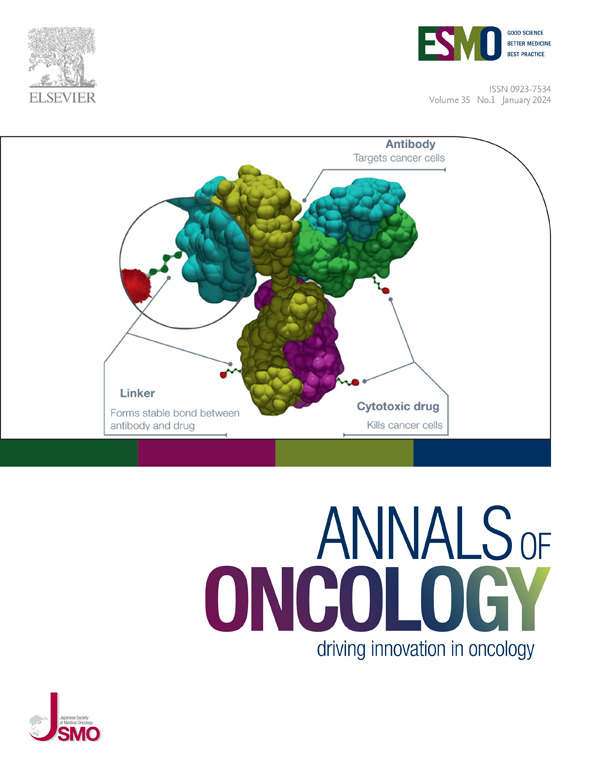Prognostic value of residual disease (RD) biology and gene expression changes during the neoadjuvant treatment in patients with HER2-positive early breast cancer (EBC)☆
IF 56.7
1区 医学
Q1 ONCOLOGY
引用次数: 0
Abstract
Background
In human epidermal growth factor receptor 2 (HER2)-positive early breast cancer (EBC), we investigated tumor and immune changes during neoadjuvant treatment and their impact on residual disease (RD) biology and prognostic implications across four neoadjuvant studies of trastuzumab with or without lapatinib, and with or without chemotherapy: CALGB 40601, PAMELA, NeoALTTO, and NSABP B-41.
Patients and methods
We compared tumor and immune gene expression changes during neoadjuvant treatment and their association with event-free survival (EFS) by uni- and multivariable Cox regression models in different cohorts and timepoints: 452 RD samples at baseline including 169 with a paired RD, and biomarker changes during neoadjuvant therapy, evaluating model performance via the c-index.
Results
Analysis of 169 paired tumor samples revealed a shift in intrinsic subtype proportions from HER2-enriched at baseline (50.3%) to normal-like (49.1%) followed by luminal A (18.9%) in RD. This luminal phenotypic change was supported by decreased correlation to the HER2-enriched centroid, ERBB2, and HER2 amplicon genes and increased correlation to the luminal A centroid (Wilcoxon test P < 0.001). Additionally, RD showed relative immune activation marked by significant increases in B-cell, CD8 T-cell, and natural killer cell signatures (Wilcoxon test P < 0.05). In multivariable Cox models, intrinsic subtypes at baseline provided more prognostic information, while immune gene expression signatures provided more prognostic information in RD. Notably, the best multivariable EFS model (c-index = 0.77) integrated the immunoglobulin G signature from RD samples (adjusted hazard ratio 0.45, 95% confidence interval 0.30-0.67, adjusted P = 0.002).
Conclusions
In patients with HER2-positive EBC and RD, tumor biomarkers provide more prognostic information at baseline. In contrast, immune biomarkers perform better for EFS prognosis in RD.
HER2+早期乳腺癌(EBC)患者新辅助治疗期间残留病(RD)生物学和基因表达变化的预后价值
背景:在HER2+早期乳腺癌(EBC)中,我们研究了4项新辅助研究中曲妥珠单抗联合或不联合拉帕替尼,以及联合或不联合化疗的肿瘤和免疫变化及其对残留疾病(RD)生物学的影响和预后意义:CALGB 40601, PAMELA, NeoALTTO和NSABP B-41。患者和方法:我们通过不同队列和时间点的单变量和多变量Cox回归模型比较了新辅助治疗期间肿瘤和免疫基因表达的变化及其与无事件生存(EFS)的关系:基线时452例RD样本(其中169例配对RD)和新辅助治疗期间生物标志物的变化,通过c指数评估模型的性能。结果:对169个配对肿瘤样本的分析显示,内在亚型比例从基线时的HER2富集(50.3%)转变为正常样(49.1%),随后是RD的Luminal a(18.9%)。这种Luminal表型变化与HER2富集质心、ERBB2和HER2扩增子基因的相关性降低,与Luminal a质心的相关性增加(wilcoxon检验p值< 0.001)。此外,RD表现出相对免疫激活,B细胞、CD8 T细胞和NK细胞特征显著增加(wilcoxon检验p值< 0.05)。在多变量Cox模型中,基线时的内在亚型提供了更多的预后信息,而免疫基因表达特征提供了更多的RD预后信息。值得注意的是,最佳多变量EFS模型(c-index = 0.77)整合了RD样本的IgG特征(校正风险比0.45,95% CI 0.30-0.67,校正p值0.002)。结论:在HER2+ EBC和RD患者中,肿瘤生物标志物在基线时提供更多的预后信息。相比之下,免疫生物标志物对RD患者的EFS预后有更好的评价。
本文章由计算机程序翻译,如有差异,请以英文原文为准。
求助全文
约1分钟内获得全文
求助全文
来源期刊

Annals of Oncology
医学-肿瘤学
CiteScore
63.90
自引率
1.00%
发文量
3712
审稿时长
2-3 weeks
期刊介绍:
Annals of Oncology, the official journal of the European Society for Medical Oncology and the Japanese Society of Medical Oncology, offers rapid and efficient peer-reviewed publications on innovative cancer treatments and translational research in oncology and precision medicine.
The journal primarily focuses on areas such as systemic anticancer therapy, with a specific emphasis on molecular targeted agents and new immune therapies. We also welcome randomized trials, including negative results, as well as top-level guidelines. Additionally, we encourage submissions in emerging fields that are crucial to personalized medicine, such as molecular pathology, bioinformatics, modern statistics, and biotechnologies. Manuscripts related to radiotherapy, surgery, and pediatrics will be considered if they demonstrate a clear interaction with any of the aforementioned fields or if they present groundbreaking findings.
Our international editorial board comprises renowned experts who are leaders in their respective fields. Through Annals of Oncology, we strive to provide the most effective communication on the dynamic and ever-evolving global oncology landscape.
 求助内容:
求助内容: 应助结果提醒方式:
应助结果提醒方式:


